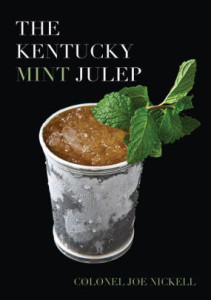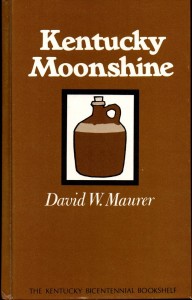Kentucky Moonshine
“They call him the king of the mountain
A Blue Ridge businessman
He’s an independent contractor
Doin’ the best that he can.”
— King of the Mountain, Southern Culture on the Skids
The late David W. Maurer, a retired University of Louisville English professor, observes some parallels between the Gin Craze as documented by Jessica Warner in Craze: Gin and Debauchery in an Age of Reason and the phenomenon of moonshining in the American South, particularly in the bourbon state of Kentucky. This is a historical and sociological look at the making and selling of illegal whiskey, which he traces all the way back to … the reign of Charles II in the late 17th century in England.
This is an informative if slim volume, whose value is undercut by the fact that it is 30 years old and hasn’t been updated since its original publication, though much has undoubtedly changed with regard to the subject.
Maurer can be an avuncular writer, as he is in the first chapter, in which he takes the reader through the process of making and using a still in his or her own kitchen. A good example of his better prose comes early, as he describes the role of the moonshiner in American society:
“The moonshiner as a criminal is so old that he has become a part of American tradition. He has become respectable in a certain sense; his reputation does not suffer in his own community in proportion to the penalties imposed on him by law. He is a sort of illegal pet, carefully protected from extermination by both the law and society, but hunted with just enough diligence to make him constantly aware that he is a criminal.”
You’ll note that the author uses the pronoun “he” exclusively. Even though this was written well before political correctness came to academic writing, this isn’t an oversight. Just about all moonshiners are men, although women are often involved in bootlegging, the transportation and sale of the product.
If the book is mostly readable, it does descend into academic gobbledygook occasionally, especially in the later chapters. This is from the chapter on the moonshiner’s vocabulary: “Professional criminal subcultures are consistently parasitic, and agglutinate (sic) against the matrix of a legitimate society already vastly experienced in symbolizing its values through language.”
The book was written before “The Dukes of Hazzard” became a popular television show in the late 1970s, but it touches on the close relationship between the bootlegging culture and that of the stock-car racers of what we now call NASCAR. The book also covers the construction of different types of stills, the social, geographic and economic factors that make Kentucky and other parts of the south particularly prone to moonshining, moonshine financing, moonshining as industry, and law enforcement.
(University Press of Kentucky, 1974/2003)
You can learn more about this book at the website of the University Press of Kentucky.
The Kentucky Mint Julep
 Joe Nickell’s little volume on the official libation of Kentucky, the mint julep, is more consistently folksy and, dare I say, easy to swallow. For such a short book (75 pages), it’s packed with information — the etymology of the word julep, a brief history of whiskey and bourbon, and a folk history of the mint julep itself.
Joe Nickell’s little volume on the official libation of Kentucky, the mint julep, is more consistently folksy and, dare I say, easy to swallow. For such a short book (75 pages), it’s packed with information — the etymology of the word julep, a brief history of whiskey and bourbon, and a folk history of the mint julep itself.
In case you don’t know, the julep is made from Kentucky whiskey, water (preferably Kentucky limestone spring water), sugar, ice and mint leaves. As with all mixed drinks of any longevity and popularity, this one can be made in many different variations, all of which have their fanatical supporters.
Nickell, an honorary Kentucky Colonel who lives in Buffalo, N.Y., gives a sampling of julep lore, a number of standard recipes, some from historic figures including the American statesman Henry Clay, and some modern recipes, even one that uses artificial sweetener. There are variations such as cordials, one that is sweetened with honey, and a champagne mint cocktail, as well as non-alcoholic mint drinks. And a blank page for you to add your own julep recipe, as well as an itinerary for a tour of seven major Kentucky distilleries.
The Kentucky Mint Julep is a beautiful little book, too, nicely produced, designed and printed.
You can learn more about this book at the University Press of Kentucky website.
(University Press of Kentucky, 2003)

